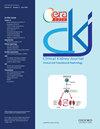重症肾病综合征对甲状腺功能、营养和凝血功能的影响
IF 3.9
2区 医学
Q1 UROLOGY & NEPHROLOGY
引用次数: 0
摘要
背景 肾病综合征(NS)的特点是尿液中蛋白质(包括激素及其载体蛋白)的流失,可能导致内分泌失调。本研究旨在评估甲状腺功能紊乱的发生频率及其对肾病综合征的潜在影响。方法 在这项病例对照研究中,对严重NS(血清白蛋白≤2.5 g/dL)患者和无蛋白尿的对照组进行了甲状腺、止血和营养参数(包括身体成分)评估。结果 42名肾病患者和40名无蛋白尿患者入选。与对照组相比,NS 组的促甲状腺激素较高,游离激素较低,因此甲状腺功能亢进综合征(ESS;36% vs 5%;OR = 10.6,95%CI:2.2-50.0)和甲状腺功能减退症(31% vs 5%;OR = 8.5,95%CI:1.8-40.7)的发病率较高。11 名 NS 患者(占 NS 组的 26%)需要补充左甲状腺素。此外,与对照组相比,NS 患者的瘦肉组织质量较低,并有高凝倾向,表现为大多数凝血因子和纤溶抑制剂水平较高,内源性抗凝活性降低。此外,患有ESS的NS患者的瘦肉组织质量降低了10.4千克(95% CI:-18.68至-2.12)。与甲状腺功能正常的NS患者相比,甲状腺功能减退患者的凝血因子X活性显著降低(降低30%,95%CI:-47至-13),蛋白S活性显著降低(降低27%,95%CI:-41至-13)。结论 甲状腺功能障碍在严重的NS患者中很常见,通常需要补充左甲状腺素,这支持常规的甲状腺检查。NS患者的甲状腺、营养和凝血功能障碍之间的潜在联系需要进一步研究。本文章由计算机程序翻译,如有差异,请以英文原文为准。
The impact of severe nephrotic syndrome on thyroid function, nutrition and coagulation
Background Nephrotic syndrome (NS) is characterized by urinary loss of proteins, including hormones and their carrier proteins, potentially resulting in endocrine disorders. This study aimed to assess thyroid dysfunction frequency and potential implications in NS. Methods In this case-control study, patients with severe NS (serum albumin ≤ 2.5 g/dL) and controls without proteinuria were evaluated for thyroid, hemostatic, and nutritional parameters, including body composition. Results Forty-two nephrotic and 40 non-proteinuric patients were enrolled. The NS group showed higher thyroid-stimulating hormone and lower free hormones, corresponding to a higher frequency of both euthyroid sick syndrome (ESS; 36% vs 5%; OR = 10.6, 95%CI: 2.2–50.0), and hypothyroidism (31% vs 5%; OR = 8.5, 95%CI: 1.8–40.7) compared to the control group. Levothyroxine supplementation was required for 11 NS patients (26% of the NS group). In addition, in comparison to the control individuals, NS patients exhibited lower lean tissue mass and a trend towards hypercoagulability, which was evidenced by higher levels of most coagulation factors and fibrinolysis inhibitors, and reduced endogenous anticoagulants activities. Furthermore, NS patients with ESS presented with a 10.4 kg (95% CI: −18.68 to −2.12) lower lean tissue mass. Those with hypothyroidism had a significantly reduced activity of coagulation factor X (by −30%, 95%CI: −47 to −13) and protein S (by −27%, 95%CI: −41 to −13) compared to euthyroid NS individuals. Conclusions Thyroid dysfunction is common in severe NS, often necessitating levothyroxine supplementation, which supports routine thyroid workup. A potential link between thyroid, nutritional, and coagulation disorders in NS requires further investigation.
求助全文
通过发布文献求助,成功后即可免费获取论文全文。
去求助
来源期刊

Clinical Kidney Journal
Medicine-Transplantation
CiteScore
6.70
自引率
10.90%
发文量
242
审稿时长
8 weeks
期刊介绍:
About the Journal
Clinical Kidney Journal: Clinical and Translational Nephrology (ckj), an official journal of the ERA-EDTA (European Renal Association-European Dialysis and Transplant Association), is a fully open access, online only journal publishing bimonthly. The journal is an essential educational and training resource integrating clinical, translational and educational research into clinical practice. ckj aims to contribute to a translational research culture among nephrologists and kidney pathologists that helps close the gap between basic researchers and practicing clinicians and promote sorely needed innovation in the Nephrology field. All research articles in this journal have undergone peer review.
 求助内容:
求助内容: 应助结果提醒方式:
应助结果提醒方式:


